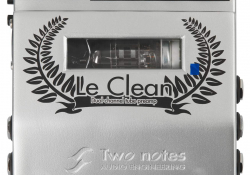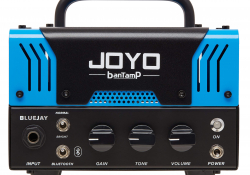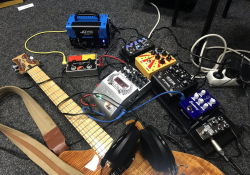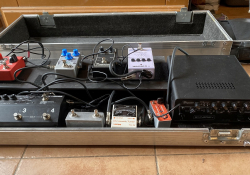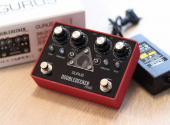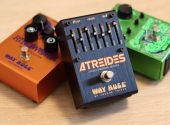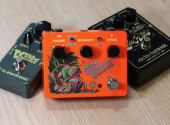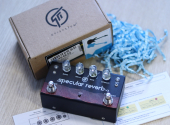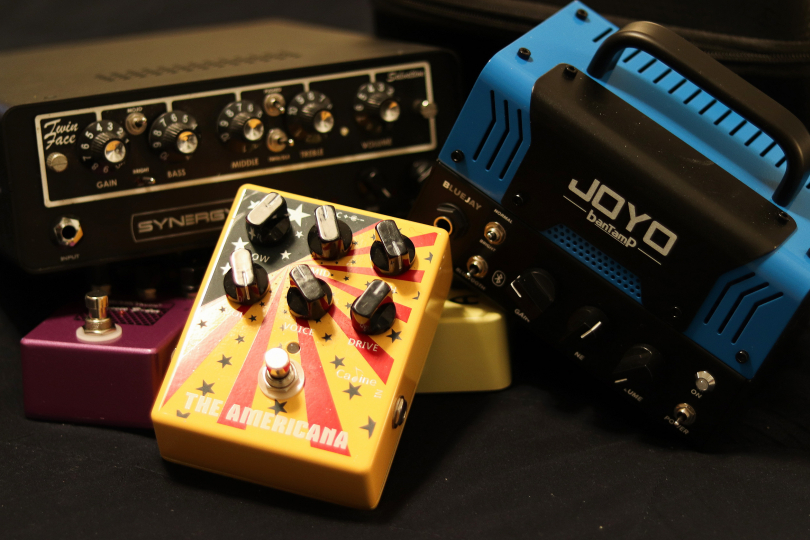
Pedalboard Gems #11: "Preampboard"
After ten episodes devoted to individual sonic gems, it's time to focus on how to deliver their exceptional sound to listeners. In today's part of our series, I would like to present you the results of my several years of research into how to achieve a good distorted sound even without the excessive volume unacceptable to the audience and, at the same time, without your back groaning under dozens of pounds of guitar gear.
Of course, you can typically plug the effects into the clean channel of your 100W tube head put on two 4 x 12 speakers equipped with some microphones... But that doesn't meet the uncompromising demands of today, where large dimensions, considerable weight, and especially excessive volume are very often to the detriment.
Unfortunately, digital simulations of distorted guitar sound, which otherwise meet these requirements do not satisfy me. I miss the liveliness of the response of the amp and such sound cannot make it in the band. In fact, over the course of a decade when I’ve been working for Salvation Audio, I've had the opportunity to try just about everything the guitar world has to offer. As a result, my demands on sound are considerable and I don't get carried away with just anything.
In this series, we're gradually showing excellent, small stompboxes—which, however, don't usually play by themselves. But to avoid the classic hard way (amp + stompbox) and to get the coveted small and sonically quality "preampboard", we need two additional things.
IR loader instead of a speaker
The first is a speaker simulator replacing a bulky loudspeaker. Impulse Response technology is already conquering all segments across the market, simply because it works. It was a real revolution and a new paradigm that allowed us to partially do away with speakers and record guitar with the feel of a roaring fullstack quietly into headphones.
My fellow IR pioneers and I always recall with a tear in our eye how we waited for someone to finally make an IR loader small enough that we could get rid of the not-quite-suitable laptop for the stage in addition to the speakers. We did wait a long ten years (because it's basically a microcomputer, and it took a while for manufacturers to get him into boxes that you can tread on), but today there's a plethora of offers in all price ranges.
From the cheapest Mooer Radar, Hotone Binary CAB, Joyo CAB BOX, or ENGL Cabloader through the mid-range AMT Pangea, Two Notes CAB M+ or the new Boss IR-200, to the absolutely ultimate UA Ox Amp Top Box, which we see in almost all well-known guitar YouTubers.
Overall, Impulses are a long story, so we'll talk more about them some other time. If you're interested, post in the comments. For now, I'll limit myself to (literally) a few essential details:
- always choose an IR loader with the ability to upload your own impulses (so-called 3rd party IR)
- avoid hardware speaker simulators (compared to IR, they are extremely buzzy and “artificial” for higher gains)
From affordable to luxury Preamps
Cool, so we've already left the speaker in the rehearsal studio, but it's still half the battle. When we wire the distortion box directly into the IR loader, it's significantly better, but often also unusably dark and generally flat. It’s because another tool is needed—a preamp of some kind. After all, distortion stompboxes are most often designed for use with a clean amp channel. This adds the required sharpness to the sound, which without it we usually have to make up for somehow. Today's range of floor preamps is already wide enough, but oh well. A usual stompbox preamp is far from "taking stompboxes well". I'm sure over twenty of them have passed through my hands, but I can only recommend a few of them for this purpose in all conscience. I've divided my proven picks again by price levels.
CALINE CP-55 "American Sound"
Preamp literally for peanuts, in the current graphic even with a cute Chinese typo Volce instead of Voice. Although we can't completely get rid of the specifically metallic accent on the mids, it can bring the sound of the stompboxes to a bearable level. For the most natural timbre, set the Voice control somewhere in the "8-10 o'clock" position and don't overdo it with the Drive. Then this toy may surprise you as pleasantly as it did me.
It's a cheap version of the long out-of-production Tech21 Blonde (à la Fender) without the switchable speaker simulation. It comes in many other variations from Joyo, Mosky, Ammoon, Harley Benton, Yuer, etc.
Another option is the "Chinese response" and the Tech21 California (à la Mesa Boogie), although this one cannot be completely cleared to clean like the previous type (which isn't necessarily a bad thing, though).
Further, an overdrive typically named AC tone is often recommended, simulating the legendary Vox AC30. I don't really understand this, because in my experience Voxes are on the contrary very picky in terms of effects, so personally, I wouldn't recommend it as a pedal platform. These analog vox emulations handle the clean sound at a high level (confirmed by a Beatles revival pro guitarist, for example).
By the way, the word "analog" is important, because as part of my research I have also tested digital preamps such as Zoom multi effects or Mooer micro preamps, but I was not satisfied with their performance. I would force myself to outlast the Mooer 006 or 019, because using them, the sound is better than the effect itself, but if you try Caline once you will easily forget about them or even send to a second-hand shop. However, the quality digital simulations (Line6 Helix etc) that easily match this category sonically are at a completely different price point. Those who find this low-cost version insufficient can look for a more demanding option.
TWO NOTES Le Clean
That's moving us on to tubes, which despite all the science and research are still irreplaceable in guitar sound. The French Le Preamp, from the pioneers of IR (think of the original Torpedo C.A.B., which, while quite large and expensive, was for a long time the only meaningful impulse option in pedalboards), offers fine-tuned features that would warrant an article of their own (parallel and series connection of two channels).
But most of all it has a really great, dynamic, inspiring, clear sound on the A channel. I've tried other preamps from this series – Le Crunch and Le Lead, but in them, the A channels are more or less a makeweight and everything important happens on the B channel. I was experimenting with Le Clean for an hour or so and was able to get colors from it ranging from the cleanest glassy s or fat clean to the accompanying almost hot crunch. Most importantly—it works great with stompboxes.
I also have to mention my partial disappointment with the AMT Bricks F-clean, which was my hot favorite as it offered everything I wanted from a pedal preamp. Great clean sound, tube, miniature size, power from a multi power supply, plus preamp/stompbox mode switching based on placement in the chain. Unfortunately, it just didn't work with the stompboxes the way I imagined.
So in terms of price/performance ratio, I consider Le Clean to be the best option to breathe life into your pedalboard at the moment, and I definitely recommend it to your attention.
Synergy SYN-1
Sheer top quality is reserved for sophisticated, expensive, and not easily available tubes from companies like Effectrode and Kingsley. As I mentioned, I am a long-time satisfied user of modular interchangeable tube preamps. In terms of operability, versatility, and sonic quality, they're the absolute top of the line, but there was no hardware small enough for them in a pedalboard. That is—until the recent arrival of the compatible single-channel chassis Synergy SYN-1.
While it has the size of a fairly large pedal, it offers completely uncompromising sound quality while still being transportable. In fact, Tony Salva (Salvation Audio) uses it in his concert pedalboard, and relatively recently Steve Vai has become a corporate player in Synergy preamps.
It's not a cheap solution, but for me, it's another welcome addition to my favorite system. For pedals, I use preamps based unsurprisingly on Fender or Marshall Plexi and I'm supremely satisfied. However, since modules aren't for everyone, I'll share my most surprising discovery yet.
Joyo Bantamp Bluejay
In my regular frustration with various products that don't work for my ear, I came across this 20W mini tube. The internet buzz about it was promising, so I took a chance. And in this case, it was an unexpected gain as well, as it takes boxes as well as the Le Clean, though, of course, it doesn't have as many adjustment options.
It does have a few blemishes though, for example, it doesn't do very well with very strong signals (pickups), the whole Bluetooth idea is totally off marketing-wise (do you really want to play music from your phone on a guitar speaker?) and the size, although literally miniature, is an example of a total waste of space when the cover is unscrewed (if the tube was horizontal, it could be stacked to the size of a pedal).
But sonically I just love it, and with the chic case, it's a neat way to add sound to stompboxes. Since the tube used is not a boutique hit, I tried swapping it for some better ones, but the difference was only in volume (gain), sonically I didn't notice any audible differences. So if you're not afraid of the unconventional starting point of the initial assignment, the Joyo Bluejay may be unexpectedly high quality yet inexpensive and small solution.
In the end, I have prepared a short illustrative step-by-step summary of what sound you can then send quite easily through a cable to a sound engineer or to your monitor or in-ear listening device.
If you have found an error or typo in the article, please let us know by e-mail info@insounder.org.


